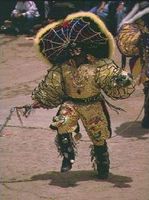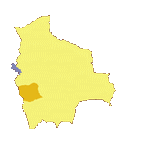The folk capital of Bolivia
 Oruro is a mining city of the altiplano
(3700m above sea level) located approximately 250km from La Paz (3 hours by bus on one of
the few asphalt roads in the country), to the North of the salt lakes Poopo and Uru Uru.
Oruro is a mining city of the altiplano
(3700m above sea level) located approximately 250km from La Paz (3 hours by bus on one of
the few asphalt roads in the country), to the North of the salt lakes Poopo and Uru Uru.
From the architectural point of view, Oruro is not of great interest to the tourist. The streets are sad and are swept by
cold winds from the altiplano. Each year, in February (the week preceding Ash Wednesday), the
carnival ![]() attracts a multitude of visitors and, for a few days, the city streets bustle with color and activity.
attracts a multitude of visitors and, for a few days, the city streets bustle with color and activity.
The Oruro carnival is one of the most famous in South America.
Historical milestones
Oruro was founded on November 1, 1606 by Manuel Castro de Padilla, under the name of "Villa de San Felipe de Austria". The city was then renamed Oruro, clearly recalling its original name of Uru-Uru, derived from the indigenous tribes Urus living on the shore of lake Poopo.
The city is built near hills rich in copper, silver and tin. Until the beginning of the XIXth century, the mines were exploited for the silver ore. When the resources were exhausted, the city suffered a massive exodus of its mining population. At the beginning of the XXth century, the city regained a new economic importance by exploiting new copper and tin reserves, in response to increasing world demand for these metals.
After the Second World War, the price of tin ore slumped. As a result of this downturn in the mining industry, Oruro was thrown into economic decline, which continues to affect the city to this day.
Carnival in Oruro
- The day before the opening ceremony (entrada), the miners sacrifice a lama in the honor of the "Tio", the God of the mine.
- The entrada of the Carnival takes place on the Saturday preceding Ash Wednesday. The folk groups (comparsa), numbering a few hundred dancers, file through the main streets of the city. The colorful representation of the Archangel Saint Michel leads the procession, followed by the devils and she-devils, bears and condors, Incas and conquistadors, vehicles decorated with treasure etc.
- On Sunday, the procession goes to the football stadium where Saint Michel, in an ultimate fight, gains victory over the demons of evil.
- Next, the participants (after removing their masks) go to the sanctuary of Virgen del Socavon in order to pay homage to the protective virgin of the mine.
- The folk and religious festivities (a mixture between Catholic ritual for the Virgin, and Indian ritual for the Pachamama) are completed in the 3 days which follow the entrada.
A couple of words of warning: water bombs and shaving foam are part of the festivities of carnival in Oruro - and a gringo in the middle of the crowd is a visible and popular target!
The principal figures of the carnival

- Archangel San Miguel
- Devils (diablos, dance=diablada, including Lucifer the Master of the demons, and China Supay, she-devil of the hills
- Incas
- Conquistadors, with F. Pizarro and D. de Almagro
- Tobas warriors, symbolizing the victories of the Inca empire.
- Morenos (dance=morenada), symbolizing the black slaves who were brought from Africa to work in the Bolivian mines
- Kallawayas, doctors of the Inca empire
- Llameros, traders representing the economic power of the Incas
- Vehicles decorated with treasures: offerings of the Incas wealth to the sun god (Inti) and of the precious ores of the miners to the Tío.
The sights of Oruro
The city is of limited interest to the tourist, but includes.
- Ethnographic mining museum
- Mineralogical museum
- Anthropologic museum (information regarding Chipayas and Urus cultures)
- Museum Patiño (residence of a wealthy tin mining tycoon)
- Monument of the revolutionary miner
- The cathedral
- The sanctuary of the Virgen del socavón on the cerro "Pie de Gallo" (mount "cock foot").
- The zoo
Around Oruro

- Historical and contemporary mines - generally closed to the public, or requiring special authorization for the visit - of San José
(no longer mined), of
La Joya
 (gigantic open cast gold mine), of Inti Raymi, of Siglo XX, and of Catavi.
(gigantic open cast gold mine), of Inti Raymi, of Siglo XX, and of Catavi. - Lake Uru Uru 10km from Oruro. A small, shallow lake, densely populated with pejerrey fish and flamingos.
- Cave paintings of Calacala 20km to the East of Oruro
- Thermal resorts of Capachos and Obrajes 20km to the North of Oruro.
- Lake Poopo 70km to the South of Oruro - a very large but shallow lake.


